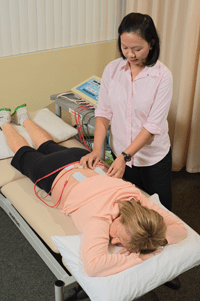Unusual Causes of Low Back Pain
By Pamela Guevarra, PT, DPT
AZOPT Physical Therapist
There is no one, specific cause of low back pain. Several reasons, including a herniated disc pushing on a nerve, the normal aging process (osteoarthritis), and faulty posture, can contribute to pain in the low back. These are only a few of the possibilities.
Beyond the abovementioned causes, low back pain can also be attributed to various unusual activities. For example, an unexpected sneeze or cough can cause severe low back pain. Other examples are stepping off a curb of unexpected height, stepping when a step does not actually exist, falling from your bed while sleeping, falling from a chair that suddenly breaks, or lifting something unexpectedly heavy, like a child.
When the lower back is strained due to an unusual activity, it will first become inflamed. The five signs of inflammation are redness, warm to the touch, pain, swelling, and loss of function. Due to the inflammation, the low back muscles will then begin to spasm. A muscle spasm is our body’s way of protecting the part from further movement, acting like a splint. However, this muscle spasm squeezes the area, causing more pain and inflammation because it does not allow the swelling to be removed. This secondary pain and inflammation in turn causes more muscle spasms and, thus, a vicious cycle begins. Pain causes inflammation, inflammation causes muscle spasms, and muscle spasms causes more pain and inflammation. This, in turn, causes loss or limited function. This same cycle can occur in other joints, as well.
Prolonged muscle spasms will induce tightness, stiffness, and impairment. To allow forward trunk bending, the muscles on the low back must gradually elongate and relax. To allow your body to return to a neutral position from a flexed one, the muscles need to slowly and smoothly contract. When there is pain and muscle spasms, attempting these two movements will cause more pain and restriction.
Pain in the low back can also occur when there are problems with the hips, knees, or ankles. Injuries, or surgeries, on any of these joints can cause abnormalities to the walking pattern, which will facilitate compensations by other muscles or joints to avoid pain. These abnormalities or compensations change your center of gravity, which strains the low back, eventually causing low back pain.
Physical therapy can help! The goal of physical therapy is to break the cycle of pain by helping you regain your range of motion and flexibility. Physical therapy will work to improve core strength and necessary lower extremity strength. A physical therapist will educate you on ways to avoid the recurrence of low back pain and assist in your ability to complete all activities of daily living. Lastly, a physical therapist will help you achieve all of your physical goals, like the return to sports, recreation, or household activities.
If you are experiencing low back pain, call AZOPT immediately to schedule an evaluation and start the process to return to pain-free living.
Reference:
Cailliet, R. (1984). Understand your backache. A guide to prevention, treatment, and relief. MA, F.A. Davis Company.








